Mental Health Nursing Practices
VerifiedAdded on 2020/02/24
|7
|1503
|52
Essay
AI Summary
This essay discusses the evolution and current practices in mental health nursing, focusing on youth aged 0-18 years. It highlights the impact of these practices on clinical and psychosocial outcomes, emphasizing the importance of evidence-based interventions and the need for culturally sensitive approaches in mental health care.
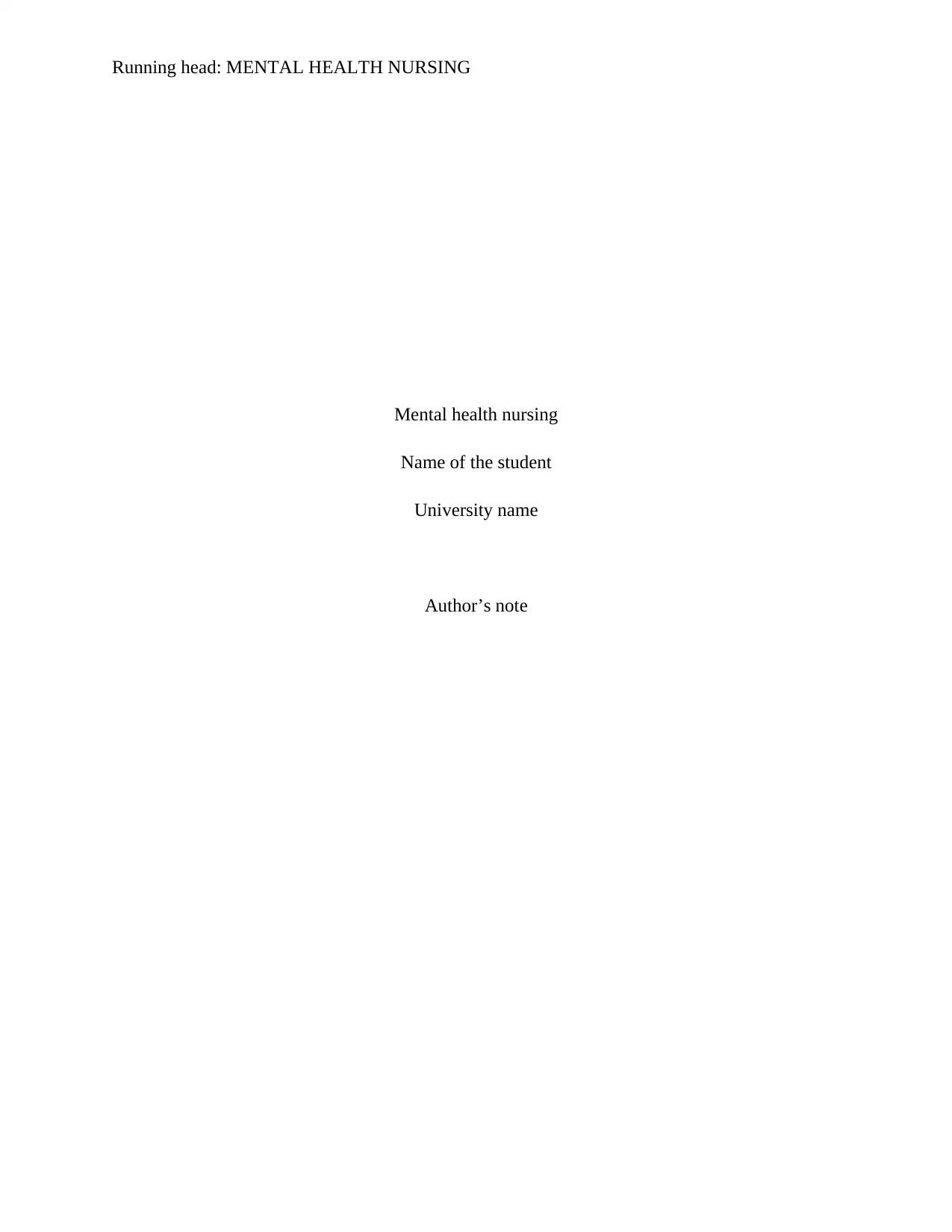
Running head: MENTAL HEALTH NURSING
Mental health nursing
Name of the student
University name
Author’s note
Mental health nursing
Name of the student
University name
Author’s note
Paraphrase This Document
Need a fresh take? Get an instant paraphrase of this document with our AI Paraphraser
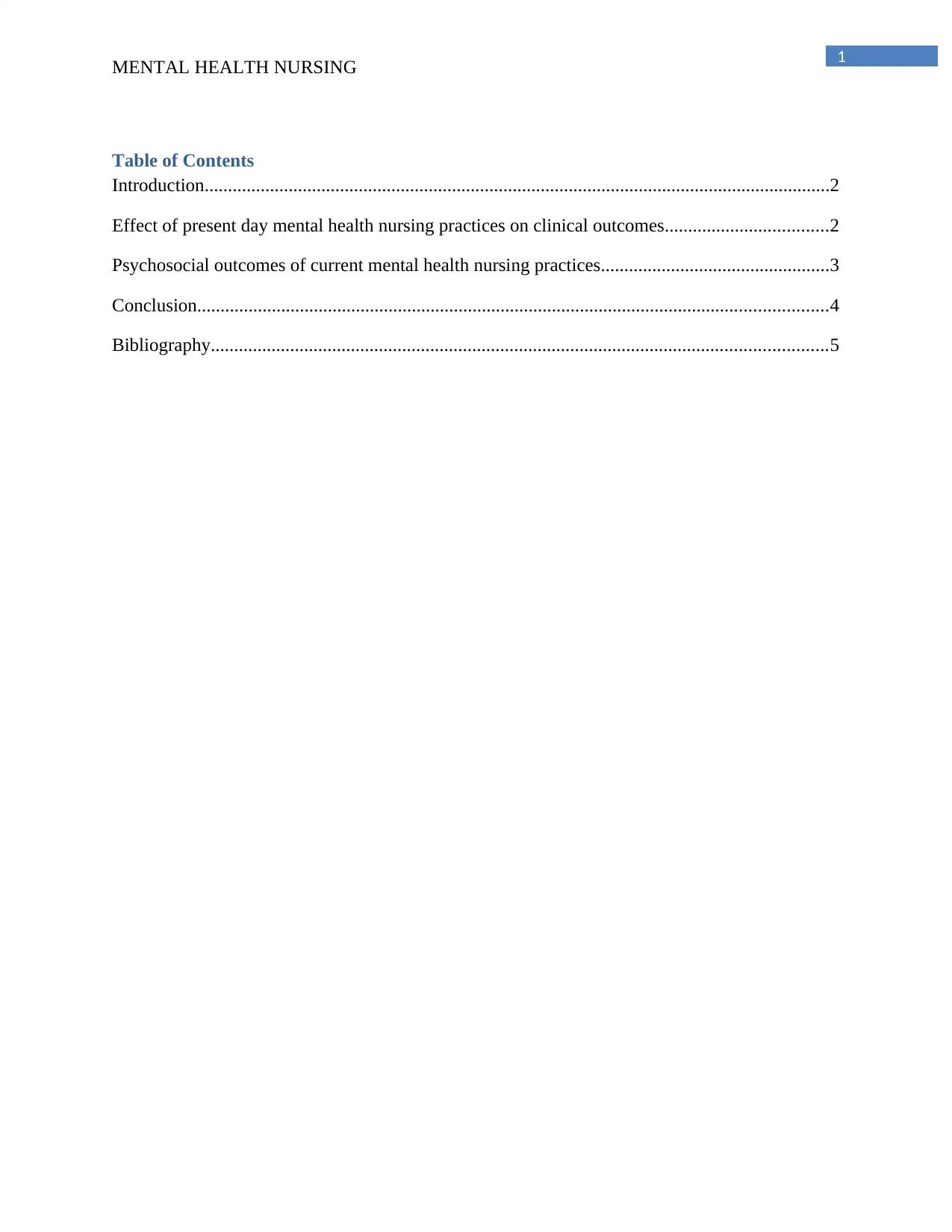
1
MENTAL HEALTH NURSING
Table of Contents
Introduction......................................................................................................................................2
Effect of present day mental health nursing practices on clinical outcomes...................................2
Psychosocial outcomes of current mental health nursing practices.................................................3
Conclusion.......................................................................................................................................4
Bibliography....................................................................................................................................5
MENTAL HEALTH NURSING
Table of Contents
Introduction......................................................................................................................................2
Effect of present day mental health nursing practices on clinical outcomes...................................2
Psychosocial outcomes of current mental health nursing practices.................................................3
Conclusion.......................................................................................................................................4
Bibliography....................................................................................................................................5
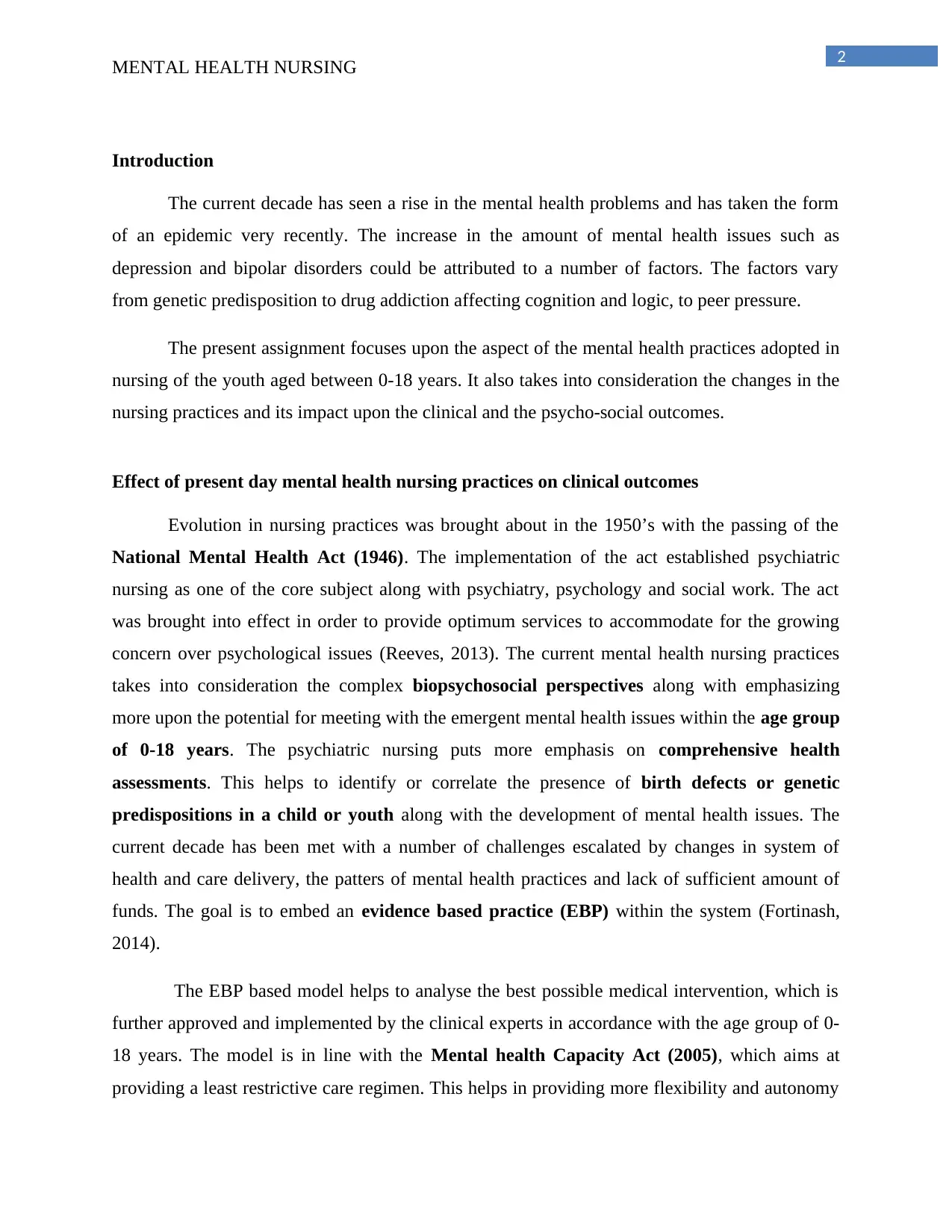
2
MENTAL HEALTH NURSING
Introduction
The current decade has seen a rise in the mental health problems and has taken the form
of an epidemic very recently. The increase in the amount of mental health issues such as
depression and bipolar disorders could be attributed to a number of factors. The factors vary
from genetic predisposition to drug addiction affecting cognition and logic, to peer pressure.
The present assignment focuses upon the aspect of the mental health practices adopted in
nursing of the youth aged between 0-18 years. It also takes into consideration the changes in the
nursing practices and its impact upon the clinical and the psycho-social outcomes.
Effect of present day mental health nursing practices on clinical outcomes
Evolution in nursing practices was brought about in the 1950’s with the passing of the
National Mental Health Act (1946). The implementation of the act established psychiatric
nursing as one of the core subject along with psychiatry, psychology and social work. The act
was brought into effect in order to provide optimum services to accommodate for the growing
concern over psychological issues (Reeves, 2013). The current mental health nursing practices
takes into consideration the complex biopsychosocial perspectives along with emphasizing
more upon the potential for meeting with the emergent mental health issues within the age group
of 0-18 years. The psychiatric nursing puts more emphasis on comprehensive health
assessments. This helps to identify or correlate the presence of birth defects or genetic
predispositions in a child or youth along with the development of mental health issues. The
current decade has been met with a number of challenges escalated by changes in system of
health and care delivery, the patters of mental health practices and lack of sufficient amount of
funds. The goal is to embed an evidence based practice (EBP) within the system (Fortinash,
2014).
The EBP based model helps to analyse the best possible medical intervention, which is
further approved and implemented by the clinical experts in accordance with the age group of 0-
18 years. The model is in line with the Mental health Capacity Act (2005), which aims at
providing a least restrictive care regimen. This helps in providing more flexibility and autonomy
MENTAL HEALTH NURSING
Introduction
The current decade has seen a rise in the mental health problems and has taken the form
of an epidemic very recently. The increase in the amount of mental health issues such as
depression and bipolar disorders could be attributed to a number of factors. The factors vary
from genetic predisposition to drug addiction affecting cognition and logic, to peer pressure.
The present assignment focuses upon the aspect of the mental health practices adopted in
nursing of the youth aged between 0-18 years. It also takes into consideration the changes in the
nursing practices and its impact upon the clinical and the psycho-social outcomes.
Effect of present day mental health nursing practices on clinical outcomes
Evolution in nursing practices was brought about in the 1950’s with the passing of the
National Mental Health Act (1946). The implementation of the act established psychiatric
nursing as one of the core subject along with psychiatry, psychology and social work. The act
was brought into effect in order to provide optimum services to accommodate for the growing
concern over psychological issues (Reeves, 2013). The current mental health nursing practices
takes into consideration the complex biopsychosocial perspectives along with emphasizing
more upon the potential for meeting with the emergent mental health issues within the age group
of 0-18 years. The psychiatric nursing puts more emphasis on comprehensive health
assessments. This helps to identify or correlate the presence of birth defects or genetic
predispositions in a child or youth along with the development of mental health issues. The
current decade has been met with a number of challenges escalated by changes in system of
health and care delivery, the patters of mental health practices and lack of sufficient amount of
funds. The goal is to embed an evidence based practice (EBP) within the system (Fortinash,
2014).
The EBP based model helps to analyse the best possible medical intervention, which is
further approved and implemented by the clinical experts in accordance with the age group of 0-
18 years. The model is in line with the Mental health Capacity Act (2005), which aims at
providing a least restrictive care regimen. This helps in providing more flexibility and autonomy
⊘ This is a preview!⊘
Do you want full access?
Subscribe today to unlock all pages.

Trusted by 1+ million students worldwide
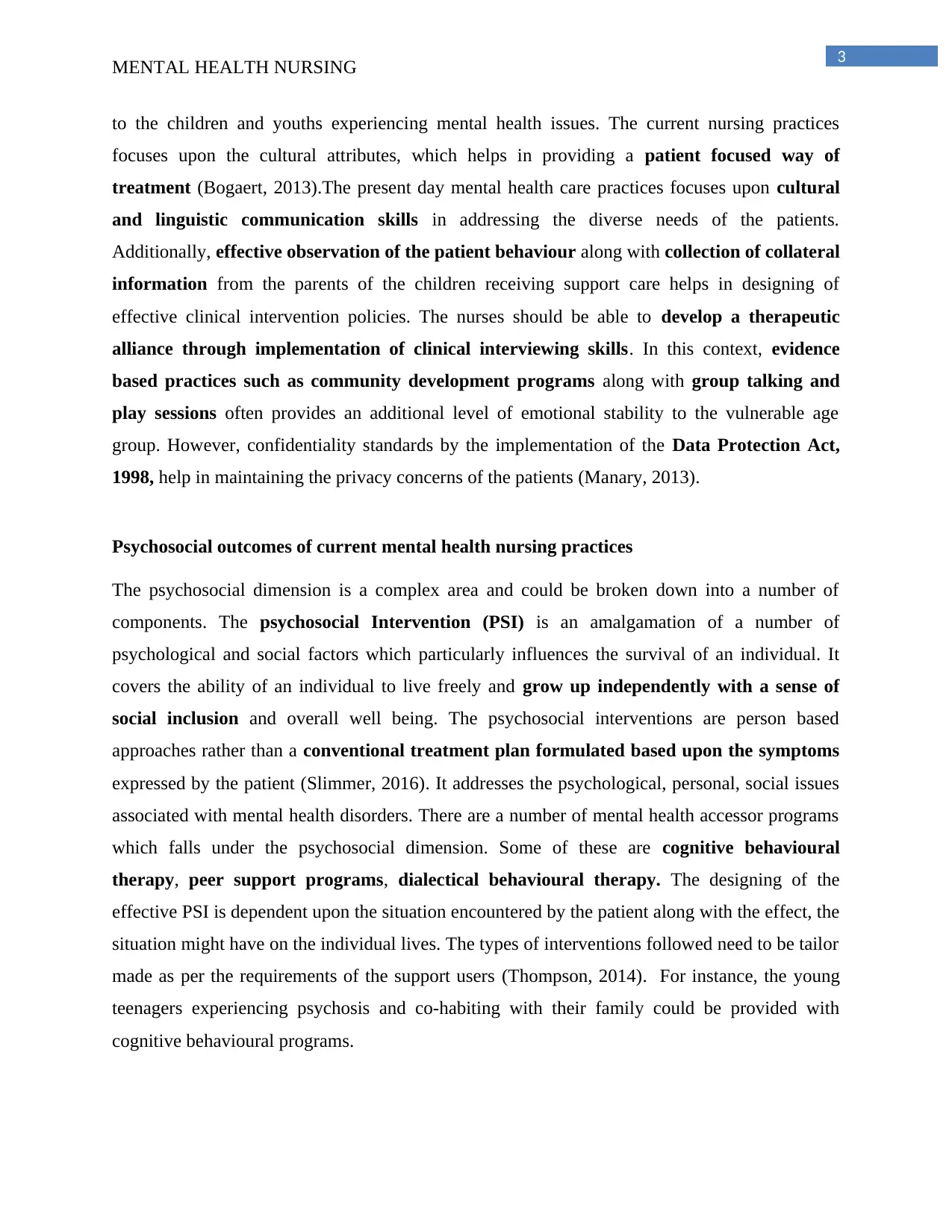
3
MENTAL HEALTH NURSING
to the children and youths experiencing mental health issues. The current nursing practices
focuses upon the cultural attributes, which helps in providing a patient focused way of
treatment (Bogaert, 2013).The present day mental health care practices focuses upon cultural
and linguistic communication skills in addressing the diverse needs of the patients.
Additionally, effective observation of the patient behaviour along with collection of collateral
information from the parents of the children receiving support care helps in designing of
effective clinical intervention policies. The nurses should be able to develop a therapeutic
alliance through implementation of clinical interviewing skills. In this context, evidence
based practices such as community development programs along with group talking and
play sessions often provides an additional level of emotional stability to the vulnerable age
group. However, confidentiality standards by the implementation of the Data Protection Act,
1998, help in maintaining the privacy concerns of the patients (Manary, 2013).
Psychosocial outcomes of current mental health nursing practices
The psychosocial dimension is a complex area and could be broken down into a number of
components. The psychosocial Intervention (PSI) is an amalgamation of a number of
psychological and social factors which particularly influences the survival of an individual. It
covers the ability of an individual to live freely and grow up independently with a sense of
social inclusion and overall well being. The psychosocial interventions are person based
approaches rather than a conventional treatment plan formulated based upon the symptoms
expressed by the patient (Slimmer, 2016). It addresses the psychological, personal, social issues
associated with mental health disorders. There are a number of mental health accessor programs
which falls under the psychosocial dimension. Some of these are cognitive behavioural
therapy, peer support programs, dialectical behavioural therapy. The designing of the
effective PSI is dependent upon the situation encountered by the patient along with the effect, the
situation might have on the individual lives. The types of interventions followed need to be tailor
made as per the requirements of the support users (Thompson, 2014). For instance, the young
teenagers experiencing psychosis and co-habiting with their family could be provided with
cognitive behavioural programs.
MENTAL HEALTH NURSING
to the children and youths experiencing mental health issues. The current nursing practices
focuses upon the cultural attributes, which helps in providing a patient focused way of
treatment (Bogaert, 2013).The present day mental health care practices focuses upon cultural
and linguistic communication skills in addressing the diverse needs of the patients.
Additionally, effective observation of the patient behaviour along with collection of collateral
information from the parents of the children receiving support care helps in designing of
effective clinical intervention policies. The nurses should be able to develop a therapeutic
alliance through implementation of clinical interviewing skills. In this context, evidence
based practices such as community development programs along with group talking and
play sessions often provides an additional level of emotional stability to the vulnerable age
group. However, confidentiality standards by the implementation of the Data Protection Act,
1998, help in maintaining the privacy concerns of the patients (Manary, 2013).
Psychosocial outcomes of current mental health nursing practices
The psychosocial dimension is a complex area and could be broken down into a number of
components. The psychosocial Intervention (PSI) is an amalgamation of a number of
psychological and social factors which particularly influences the survival of an individual. It
covers the ability of an individual to live freely and grow up independently with a sense of
social inclusion and overall well being. The psychosocial interventions are person based
approaches rather than a conventional treatment plan formulated based upon the symptoms
expressed by the patient (Slimmer, 2016). It addresses the psychological, personal, social issues
associated with mental health disorders. There are a number of mental health accessor programs
which falls under the psychosocial dimension. Some of these are cognitive behavioural
therapy, peer support programs, dialectical behavioural therapy. The designing of the
effective PSI is dependent upon the situation encountered by the patient along with the effect, the
situation might have on the individual lives. The types of interventions followed need to be tailor
made as per the requirements of the support users (Thompson, 2014). For instance, the young
teenagers experiencing psychosis and co-habiting with their family could be provided with
cognitive behavioural programs.
Paraphrase This Document
Need a fresh take? Get an instant paraphrase of this document with our AI Paraphraser
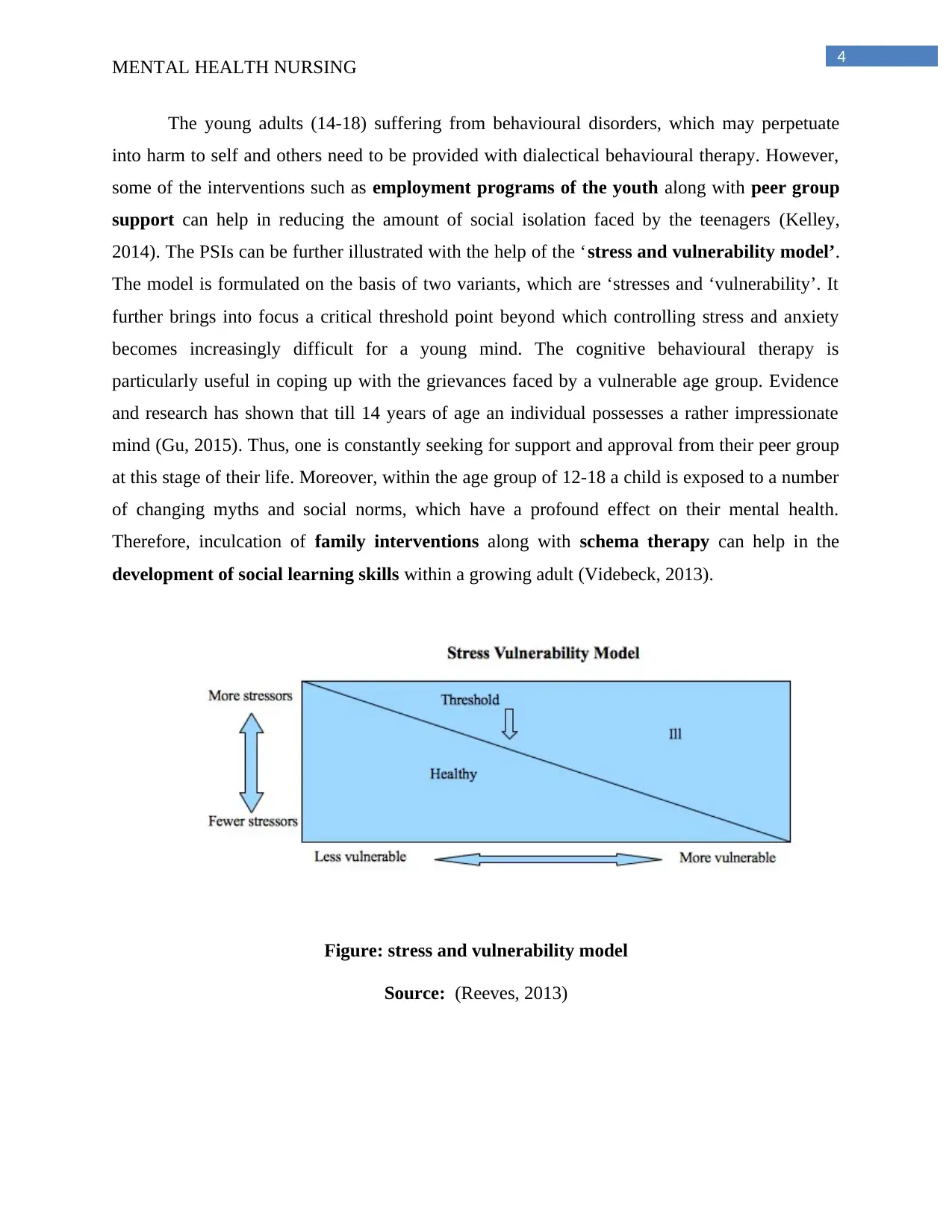
4
MENTAL HEALTH NURSING
The young adults (14-18) suffering from behavioural disorders, which may perpetuate
into harm to self and others need to be provided with dialectical behavioural therapy. However,
some of the interventions such as employment programs of the youth along with peer group
support can help in reducing the amount of social isolation faced by the teenagers (Kelley,
2014). The PSIs can be further illustrated with the help of the ‘stress and vulnerability model’.
The model is formulated on the basis of two variants, which are ‘stresses and ‘vulnerability’. It
further brings into focus a critical threshold point beyond which controlling stress and anxiety
becomes increasingly difficult for a young mind. The cognitive behavioural therapy is
particularly useful in coping up with the grievances faced by a vulnerable age group. Evidence
and research has shown that till 14 years of age an individual possesses a rather impressionate
mind (Gu, 2015). Thus, one is constantly seeking for support and approval from their peer group
at this stage of their life. Moreover, within the age group of 12-18 a child is exposed to a number
of changing myths and social norms, which have a profound effect on their mental health.
Therefore, inculcation of family interventions along with schema therapy can help in the
development of social learning skills within a growing adult (Videbeck, 2013).
Figure: stress and vulnerability model
Source: (Reeves, 2013)
MENTAL HEALTH NURSING
The young adults (14-18) suffering from behavioural disorders, which may perpetuate
into harm to self and others need to be provided with dialectical behavioural therapy. However,
some of the interventions such as employment programs of the youth along with peer group
support can help in reducing the amount of social isolation faced by the teenagers (Kelley,
2014). The PSIs can be further illustrated with the help of the ‘stress and vulnerability model’.
The model is formulated on the basis of two variants, which are ‘stresses and ‘vulnerability’. It
further brings into focus a critical threshold point beyond which controlling stress and anxiety
becomes increasingly difficult for a young mind. The cognitive behavioural therapy is
particularly useful in coping up with the grievances faced by a vulnerable age group. Evidence
and research has shown that till 14 years of age an individual possesses a rather impressionate
mind (Gu, 2015). Thus, one is constantly seeking for support and approval from their peer group
at this stage of their life. Moreover, within the age group of 12-18 a child is exposed to a number
of changing myths and social norms, which have a profound effect on their mental health.
Therefore, inculcation of family interventions along with schema therapy can help in the
development of social learning skills within a growing adult (Videbeck, 2013).
Figure: stress and vulnerability model
Source: (Reeves, 2013)
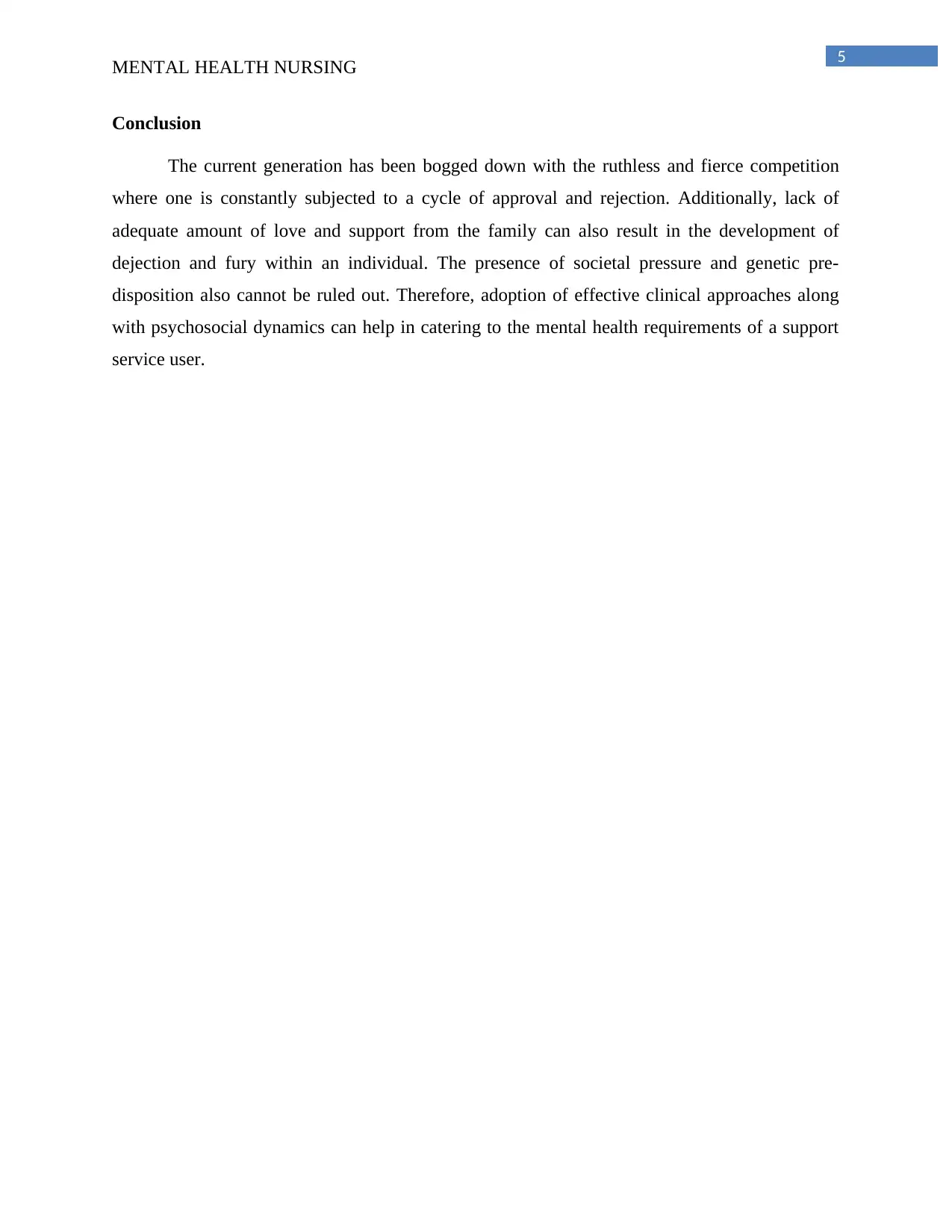
5
MENTAL HEALTH NURSING
Conclusion
The current generation has been bogged down with the ruthless and fierce competition
where one is constantly subjected to a cycle of approval and rejection. Additionally, lack of
adequate amount of love and support from the family can also result in the development of
dejection and fury within an individual. The presence of societal pressure and genetic pre-
disposition also cannot be ruled out. Therefore, adoption of effective clinical approaches along
with psychosocial dynamics can help in catering to the mental health requirements of a support
service user.
MENTAL HEALTH NURSING
Conclusion
The current generation has been bogged down with the ruthless and fierce competition
where one is constantly subjected to a cycle of approval and rejection. Additionally, lack of
adequate amount of love and support from the family can also result in the development of
dejection and fury within an individual. The presence of societal pressure and genetic pre-
disposition also cannot be ruled out. Therefore, adoption of effective clinical approaches along
with psychosocial dynamics can help in catering to the mental health requirements of a support
service user.
⊘ This is a preview!⊘
Do you want full access?
Subscribe today to unlock all pages.

Trusted by 1+ million students worldwide
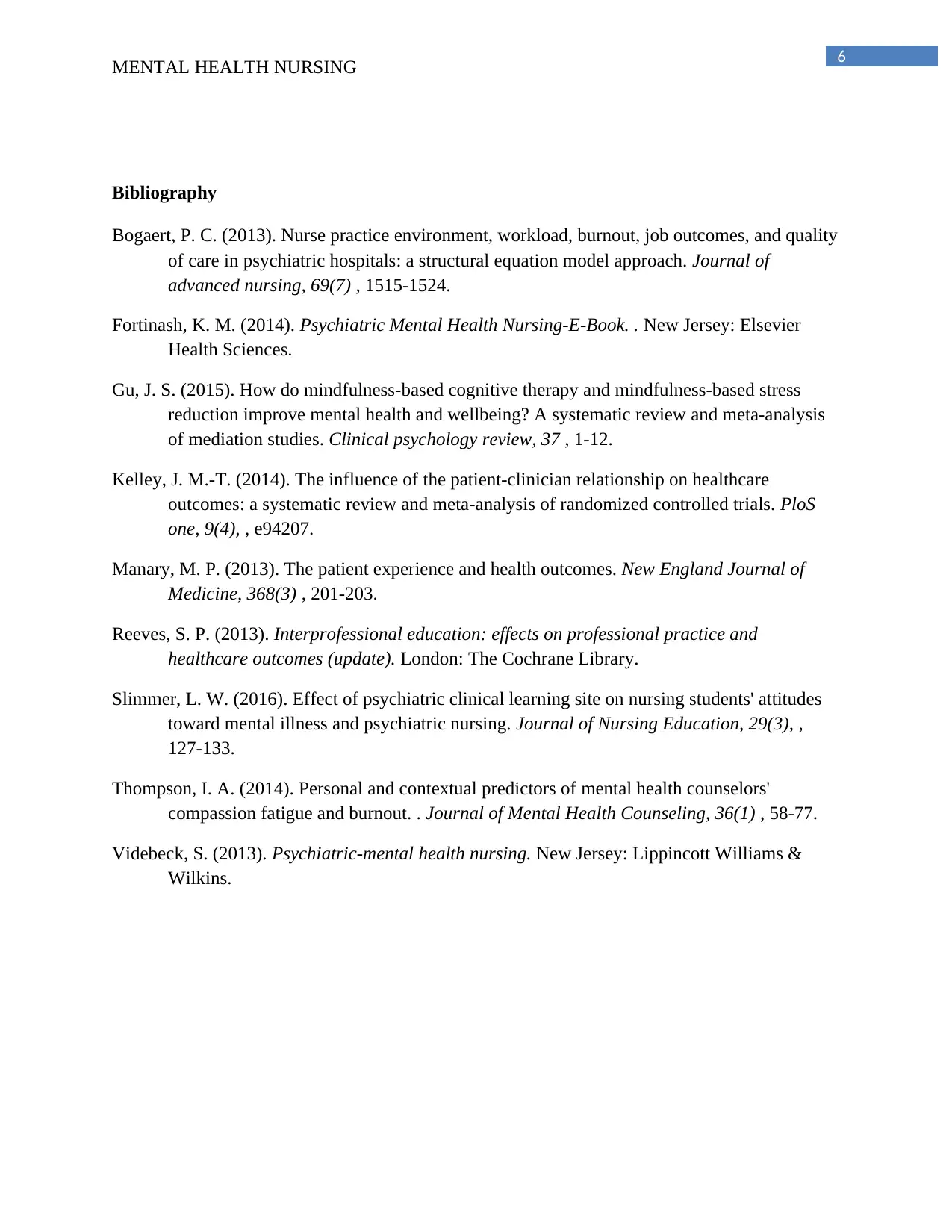
6
MENTAL HEALTH NURSING
Bibliography
Bogaert, P. C. (2013). Nurse practice environment, workload, burnout, job outcomes, and quality
of care in psychiatric hospitals: a structural equation model approach. Journal of
advanced nursing, 69(7) , 1515-1524.
Fortinash, K. M. (2014). Psychiatric Mental Health Nursing-E-Book. . New Jersey: Elsevier
Health Sciences.
Gu, J. S. (2015). How do mindfulness-based cognitive therapy and mindfulness-based stress
reduction improve mental health and wellbeing? A systematic review and meta-analysis
of mediation studies. Clinical psychology review, 37 , 1-12.
Kelley, J. M.-T. (2014). The influence of the patient-clinician relationship on healthcare
outcomes: a systematic review and meta-analysis of randomized controlled trials. PloS
one, 9(4), , e94207.
Manary, M. P. (2013). The patient experience and health outcomes. New England Journal of
Medicine, 368(3) , 201-203.
Reeves, S. P. (2013). Interprofessional education: effects on professional practice and
healthcare outcomes (update). London: The Cochrane Library.
Slimmer, L. W. (2016). Effect of psychiatric clinical learning site on nursing students' attitudes
toward mental illness and psychiatric nursing. Journal of Nursing Education, 29(3), ,
127-133.
Thompson, I. A. (2014). Personal and contextual predictors of mental health counselors'
compassion fatigue and burnout. . Journal of Mental Health Counseling, 36(1) , 58-77.
Videbeck, S. (2013). Psychiatric-mental health nursing. New Jersey: Lippincott Williams &
Wilkins.
MENTAL HEALTH NURSING
Bibliography
Bogaert, P. C. (2013). Nurse practice environment, workload, burnout, job outcomes, and quality
of care in psychiatric hospitals: a structural equation model approach. Journal of
advanced nursing, 69(7) , 1515-1524.
Fortinash, K. M. (2014). Psychiatric Mental Health Nursing-E-Book. . New Jersey: Elsevier
Health Sciences.
Gu, J. S. (2015). How do mindfulness-based cognitive therapy and mindfulness-based stress
reduction improve mental health and wellbeing? A systematic review and meta-analysis
of mediation studies. Clinical psychology review, 37 , 1-12.
Kelley, J. M.-T. (2014). The influence of the patient-clinician relationship on healthcare
outcomes: a systematic review and meta-analysis of randomized controlled trials. PloS
one, 9(4), , e94207.
Manary, M. P. (2013). The patient experience and health outcomes. New England Journal of
Medicine, 368(3) , 201-203.
Reeves, S. P. (2013). Interprofessional education: effects on professional practice and
healthcare outcomes (update). London: The Cochrane Library.
Slimmer, L. W. (2016). Effect of psychiatric clinical learning site on nursing students' attitudes
toward mental illness and psychiatric nursing. Journal of Nursing Education, 29(3), ,
127-133.
Thompson, I. A. (2014). Personal and contextual predictors of mental health counselors'
compassion fatigue and burnout. . Journal of Mental Health Counseling, 36(1) , 58-77.
Videbeck, S. (2013). Psychiatric-mental health nursing. New Jersey: Lippincott Williams &
Wilkins.
1 out of 7
Related Documents
Your All-in-One AI-Powered Toolkit for Academic Success.
+13062052269
info@desklib.com
Available 24*7 on WhatsApp / Email
![[object Object]](/_next/static/media/star-bottom.7253800d.svg)
Unlock your academic potential
Copyright © 2020–2025 A2Z Services. All Rights Reserved. Developed and managed by ZUCOL.





